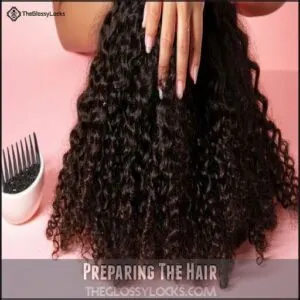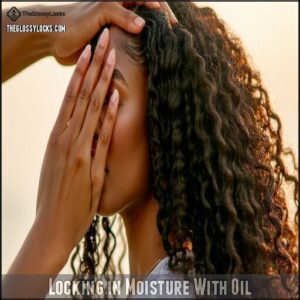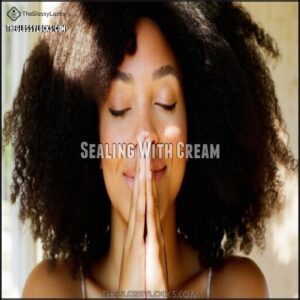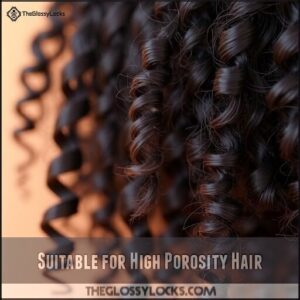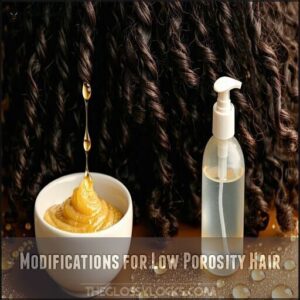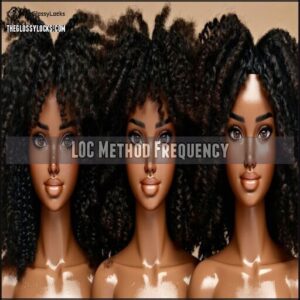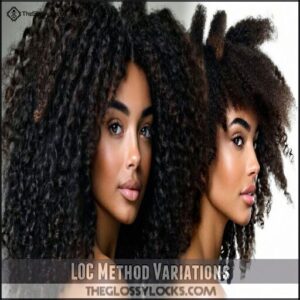This site is supported by our readers. We may earn a commission, at no cost to you, if you purchase through links.
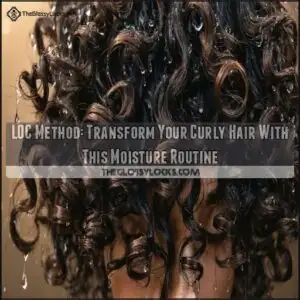 You’ll love the LOC method if you’re battling dry, curly hair.
You’ll love the LOC method if you’re battling dry, curly hair.
This three-step technique (Leave-in conditioner, Oil, Cream) locks moisture into your curls like a charm. First, apply a water-based leave-in to damp hair.
Next, add your favorite oil—jojoba and argan work wonders—to trap that hydration. Finally, seal everything with a cream product to prevent moisture from escaping.
Think of it as building a moisture fortress around each curl. Your hair type determines which products will work best, and sometimes switching the order (LCO) might be your ticket to bounce-back curls that turn heads.
Table Of Contents
- Key Takeaways
- What is LOC Method
- LOC Method Steps
- Top 5 LOC Products
- LOC Method for Hair Types
- LOC Method Frequency
- LOC Method Variations
- Frequently Asked Questions (FAQs)
- Should you put LOC method on wet or dry hair?
- Which is better, loc or lco?
- What is the loc process?
- Which LOC method is better?
- What is the difference between LCO method and LOC method?
- How often should I do the loc method?
- Do you do the LOC method on wet hair?
- What oils are best for LOC method?
- How often should I do the LOC method?
- Does the LOC method actually grow hair?
- Conclusion
Key Takeaways
- You can lock in moisture for your curls with the LOC method by layering a leave-in conditioner, oil, and cream in that order.
- High-porosity hair retains moisture better with LOC, while low-porosity hair benefits more from the LCO method (liquid-cream-oil).
- Always apply the LOC method to damp hair for the best absorption and effective sealing of moisture.
- Use lightweight oils like jojoba for fine hair or heavier oils like castor for thicker, drier strands to get optimal results.
What is LOC Method
The LOC method is a simple hair routine that locks in moisture using three steps: leave-in conditioner, oil, and cream.
It’s perfect for keeping curly and wavy hair hydrated, soft, and manageable.
Definition and Benefits
The LOC method, short for Liquid, Oil, Cream, is a game-changer for curly and coily hair.
It boosts hydration, locks in moisture, and fights frizz, leaving you with defined curls and improved hair health.
By layering products in this specific order, you guarantee maximal moisture retention, which is perfect for transforming dry, brittle strands into hydrated, manageable locks, and achieving maximal moisture retention with defined curls.
How It Works for Curly Hair
Curly hair thrives when moisture retention is maximized.
The loc method layers hydration techniques using a liquid leave-in, oil, and cream, working wonders for curl definition.
High hair porosity benefits most, as the process locks in hydration and combats dryness.
It’s a moisture game-changer for natural hair, leaving your curls bouncy, nourished, and vibrant without the crunch.
Understanding leave in conditioner benefits is key to achieving ideal results with the loc method, making it a crucial step for natural hair.
History and Origin
The loc hair method has deep natural roots. Created by Rochelle Graham, the founder of Alikay Naturals, this approach became a game-changer for natural hair care.
Originally designed for textured hair, it’s now embraced worldwide. Here’s why:
- The loc meaning in hair treatment focuses on moisture.
- It transformed crunchy strands into hydrated curls.
- Alikay Naturals popularized it.
- Hair history redefined!
The loc method emphasizes the importance of hair moisture retention for healthy curls, which is a key factor in hair care.
LOC Method Steps
To get the most out of the LOC method, it’s important to follow the steps in the right order.
Start with damp hair and layer your leave-in conditioner, oil, and cream to lock in moisture and keep your curls hydrated.
Preparing The Hair
Before starting the LOC method, proper hair preparation is key for moisture retention.
Begin with pre-shampooing or hair steaming to boost hydration.
Use hair sectioning for better control and follow smart detangling tips to avoid breakage.
Focus on clean, damp hair—tailored to your hair porosity.
This natural hair care step guarantees a smooth start for locking in moisture.
Applying Leave-in Conditioner
When applying a leave-in conditioner, less is more—don’t overdo it.
Choose a liquid conditioner suited to your hair porosity for maximum moisture retention. Section your hair for even application, focusing on ends where dryness creeps in.
Application techniques like raking or “praying hands” guarantee full coverage. These leave-in tips lay the foundation for the LOC method’s success.
Using the right leave in products can make a significant difference in the effectiveness of the LOC method.
Locking in Moisture With Oil
Now that your leave-in conditioner is applied, it’s time for oil! Natural hair oils for locs, like jojoba or avocado, shine here.
Proper hair moisture sealing is essential for healthy hair.
Oil benefits include locking in moisture and boosting hair sealing to keep strands hydrated.
To master moisture retention, glide a thin layer using "praying hands." This step secures hydration, so your hair stays soft and happy!
Sealing With Cream
The final step in your LOC method journey is sealing with cream. This essential layer locks in all that hydration you’ve worked so hard to achieve.
You can find a variety of hair sealing cream products online. Choose a butter-based cream product that complements your hair porosity – heavier for high porosity, lighter for low.
Apply using the praying hands technique, distributing evenly from roots to ends. Avoid common mistakes like using too much, which can weigh down your curls.
Top 5 LOC Products
You’ll find these five essential products make all the difference in your LOC routine, saving your curls from dryness without emptying your wallet.
Each product has been selected for its ability to lock in moisture effectively, helping you achieve those bouncy, defined curls you’ve been dreaming about, with the ultimate goal of achieving bouncy curls.
1. Grapeseed Oil Skin Care Moisturizer
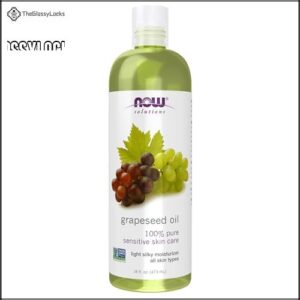
Grapeseed oil’s lightweight texture makes it a perfect choice for the oil step in your LOC method routine.
This 100% pure oil absorbs quickly without leaving a greasy residue, making it ideal for all hair types.
Its composition of essential fatty acids helps lock in moisture while creating a protective barrier around your strands.
You’ll appreciate how this versatile, odorless oil smooths frizz without weighing down your curls.
The generous 10.58-ounce bottle offers excellent value, especially since you only need a small amount for each application.
Your curls will thank you!
Best For: Individuals with curly, wavy, or coily hair seeking a lightweight, non-greasy oil to lock in moisture and reduce frizz.
Pros:- Absorbs quickly without leaving a greasy residue.
- Versatile for both hair and skincare.
- Affordable price with a generous bottle size.
Cons:- Requires layering with other products for maximum moisture retention in the LOC method.
- May not provide enough hydration alone for extremely dry hair.
- Limited scent may not appeal to some users.
2. Organic Jojoba Oil for Hair Skin and Face
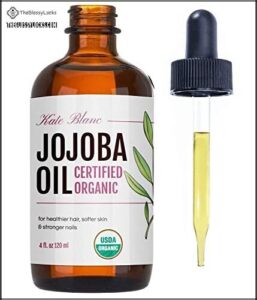
After searching for the perfect oil for your LOC method, organic jojoba oil stands out as a versatile powerhouse.
This USDA-certified, cold-pressed, hexane-free option comes in a convenient 7.83-ounce bottle that packs a serious moisture punch.
You’ll love how it easily absorbs into both hair and skin without leaving a greasy residue.
It’s particularly effective for locking in moisture during the "O" step of your routine, helping to soften hair, reduce frizz, and treat dry scalp conditions.
Many users report it’s worth every penny for its multi-use benefits.
Best For: Individuals looking for a versatile, organic oil to hydrate skin, soften hair, and enhance the LOC method for moisture retention.
- USDA-certified organic, cold-pressed, and hexane-free.
- Absorbs easily without leaving a greasy residue.
- Multi-use benefits for skin, hair, nails, and scalp.
- Packaging issues reported with product spillage.
- May not be ideal for those who prefer scented oils.
- Slightly pricier compared to other oils on the market.
3. Coconut Curl Shine Hair Conditioner
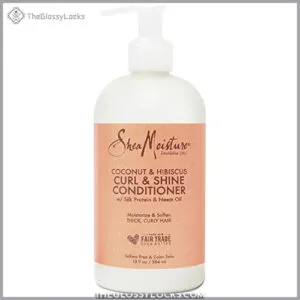
The SheaMoisture Coconut & Hibiscus Conditioner steps up your LOC routine with powerful moisture-locking capabilities.
This conditioner transforms dry, brittle curls into vibrant, bouncy waves by enhancing elasticity and defining natural curl patterns.
It’s blended with Neem Oil to repair damage, add shine, and promote overall hair health.
Free from harsh chemicals like silicones, sulfates, and parabens, this product contains fair trade shea butter for maximum hydration.
Use it as the "L" in your LOC method to instantly hydrate and define curls, leaving them soft, detangled, and frizz-free.
Best For: People with wavy, curly, or coily hair looking for intense hydration, curl definition, and frizz control.
Pros:- Hydrates and defines curls, leaving them soft and frizz-free.
- Free from harsh chemicals like silicones, sulfates, and parabens.
- Contains fair trade shea butter and Neem Oil to repair and enhance shine.
Cons:- May be too rich for fine or low porosity hair, risking buildup.
- Coconut fragrance may not suit everyone’s preference.
- Requires pairing with other products for complete LOC routine effectiveness.
4. Haitian Black Castor Oil Serum
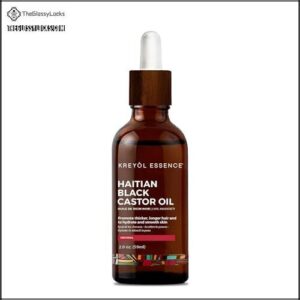
Consistently recommended by celebrity hairstylist Takisha Sturdivant-Drew, Haitian Black Castor Oil Serum stands out as a powerhouse in the LOC method.
This thick, organic formula deeply penetrates your hair shaft, locking in moisture while promoting healthier, thicker growth.
Simply apply it to your scalp and hair 3-4 times weekly, massaging gently to stimulate follicles.
You’ll appreciate how it soothes your scalp while adding a natural shine without weighing down your curls.
For deeper conditioning, mix it with your regular conditioner or apply with heat for 30-60 minutes, which can help with healthier and thicker growth, making it a great addition to your hair care routine for a natural shine.
Best For: Individuals with dry, curly, or damaged hair looking for a natural solution to promote hair growth, moisture retention, and scalp health.
- Thick consistency may not suit fine or low porosity hair.
- Distinct smell might not appeal to everyone.
- Requires consistent use for noticeable results.
- Promotes healthier, thicker hair growth with regular use.
- Deeply moisturizes and conditions hair and scalp.
- Versatile product for both hair and skin care.
5. Organic Olive Oil Skin Care
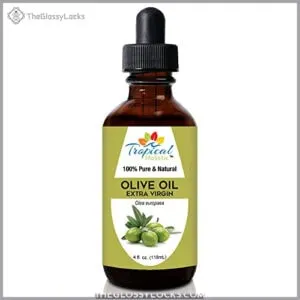
You can round out your LOC method with organic extra virgin olive oil, a versatile option that pulls double duty for both hair and skin care.
This Tunisian-sourced oil is cold pressed and unrefined, preserving all its beneficial properties, and its greenish-yellow hue and natural earthy fragrance signal its purity and effectiveness.
The 4 oz bottle delivers quick absorption without greasiness, making it ideal for locking in moisture during the "O" step of your routine, and it’s free from chemicals, which makes it gentle enough for sensitive skin and even children’s hair care needs.
Best For: Those seeking a natural, organic solution for skin and hair care, including individuals with sensitive skin and caregivers looking after children.
- Cold-pressed and unrefined to retain maximum purity and effectiveness.
- Quick absorption without greasiness, suitable for various hair and skin types.
- Free from chemicals, making it safe for sensitive skin and children.
- Limited to a4 oz bottle, which may not last long with frequent use.
- The natural fragrance may not appeal to everyone.
- Not specifically formulated for certain specialized hair or skin needs.
LOC Method for Hair Types
You’ll find the LOC method works differently across hair types, with high porosity curls soaking up moisture like a sponge while low porosity waves might need adjustments.
Your unique curl pattern and porosity level will determine how you’ll benefit from this moisture-locking technique, so don’t worry if you need to tweak the process to find your hair’s happy place.
Suitable for High Porosity Hair
Now that you’ve got your product lineup ready, let’s talk about why the LOC method works wonders specifically for high porosity hair. If your curls drink up moisture but can’t seem to hold onto it, you’ve likely got high porosity hair.
The LOC method fundamentals involve layering leave-in, oil, and cream.
- Absorb products quickly but dry out fast
- Feel rough or dry to the touch
- Frizz easily, especially in humidity
- Look dull rather than shiny
Benefits for Wavy and Curly Hair
Wavy and curly hair types thrive with the LOC method because it addresses their unique moisture needs.
Your waves and curls will enjoy significant frizz reduction and enhanced shine after application.
The layering technique creates a hydration boost that improves curl definition while preventing moisture loss. You’ll notice your hair patterns become more pronounced and manageable as the products work together to seal your cuticles and repair damage, leading to enhanced shine.
Modifications for Low Porosity Hair
Your hair’s porosity level plays a vital role in how it absorbs moisture. If you have low porosity hair, the LOC method needs some tweaking to truly work for you.
Try these 5 modifications for low porosity locs:
- Switch to the LCO method (liquid-cream-oil) sequence
- Choose lighter oils like grapeseed or jojoba
- Use water-based products that penetrate more easily
- Apply a pre-poo treatment before washing
- Reduce product amounts to prevent buildup
LOC Method Frequency
You’ll need to apply the LOC method every 3-4 days depending on your unique hair needs and environmental conditions.
The frequency of application should be adjusted based on how quickly your hair loses moisture, with high porosity curls typically needing more frequent treatments than low porosity hair types.
How Often to Apply
While finding your perfect LOC method frequency depends largely on your hair’s unique needs, most people apply this moisturizing routine every 3-5 days.
Apply the LOC method every3-5 days to keep your curls hydrated, frizz-free, and perfectly defined.
Your hair porosity, styling routine, and even climate conditions all play vital roles in determining how often you’ll need to moisturize your locks.
The key factors to consider are hair porosity, styling routine, and climate conditions, as they significantly influence the frequency of moisturizing, with signs such as dryness and frizz indicating it’s time to reapply.
Factors Affecting Frequency
Your LOC method schedule isn’t one-size-fits-all.
Several factors determine how often you’ll need to moisturize: hair porosity (high porosity needs more frequent applications), hair texture (tighter curls typically require more hydration), climate (drier environments demand more moisture), styling habits (heat styling increases frequency needs), and products used (heavier products may extend time between applications).
The LOC method for straight hair can also be effective.
Understanding these elements helps you customize your hair routine for ideal results.
Tips for Maintaining Moisture
In addition to the LOC method, adopt these moisture-maintaining strategies for lasting hydration.
Protect your curls while sleeping with a satin bonnet or pillowcase. Refresh your hair between washes using a water-based spray.
Deep condition weekly to replenish moisture reserves. When dealing with humidity, use anti-humectant products to prevent frizz.
Remember, consistent product layering through the LOC method is key to maintaining well-moisturized natural hair, and it is crucial for lasting hydration.
LOC Method Variations
You’ll find several useful tweaks to the classic LOC method that can better suit your specific hair needs.
These variations like LCO, LOCS, and LOCO offer alternative layering sequences that might work better for your unique curl pattern and porosity level.
LCO Method for Low Porosity Hair
For those with low porosity hair, the LCO method offers a strategic twist on the classic LOC technique.
Unlike high porosity strands, your hair resists moisture absorption, making product order vital for maximum benefits.
The LCO method prioritizes product penetration. Apply liquid first to dampen resistant hair cuticles.
Follow with cream to provide needed hydration before sealing. Finish with lightweight oils like argan or avocado rather than heavy ones.
This sequence prevents product buildup while ensuring ideal moisture retention.
LOCS Method for Extra Hydration
Need an intense hydration boost for your thirsty curls? The LOCS Method (Liquid, Oil, Cream, Sealant) adds a powerful final step to the traditional LOC method.
You can find a variety of hair sealant product options to help with this process.
After completing your regular moisturizing routine, apply a heavy butter like shea, cocoa, or mango as a sealant. This extra layer locks in moisture for extended periods, making it perfect before protective styling when high porosity hair needs maximum moisture retention.
LOCO Method for Optimum Moisture Retention
The LOCO Method—a moisture powerhouse—takes your hair hydration to the next level by using two strategic oil applications.
This technique (Liquid, Oil, Cream, Oil) sandwiches your styling products between lightweight oils like coconut and heavier ones like castor.
Perfect for fine to medium-textured natural hair, this variation helps maintain moisture longer than standard LOC or LCO methods.
You’ll notice improved definition and reduced frizz with consistent use.
Frequently Asked Questions (FAQs)
Should you put LOC method on wet or dry hair?
Always apply the LOC method to wet hair.
The liquid component absorbs best on damp strands, allowing oils and creams to effectively seal in moisture.
Dry hair won’t receive the same hydration benefits.
Which is better, loc or lco?
Like two sides of a moisturizing coin, LOC works better for high porosity hair that quickly loses moisture.
While LCO is ideal for low porosity hair that repels moisture.
Your hair’s needs determine the winner.
What is the loc process?
You’ll apply leave-in conditioner to damp hair first, followed by oil to seal in moisture, then finish with cream to define your curls.
This three-step process helps maximize hydration for your hair.
Which LOC method is better?
The best LOC method depends on your hair’s porosity. You’ll want LOC (Liquid-Oil-Cream) for high-porosity hair and LCO (Liquid-Cream-Oil) for low-porosity hair. Test both to find your perfect moisture match!
What is the difference between LCO method and LOC method?
Think of hair care like layering clothes for weather – the order matters.
LOC (Liquid-Oil-Cream) works better for high-porosity hair that quickly loses moisture, while LCO (Liquid-Cream-Oil) suits low-porosity hair that resists absorption.
How often should I do the loc method?
You should apply the LOC method every 3-4 days, depending on your hair’s dryness level.
If you notice your curls losing moisture or definition sooner, don’t hesitate to reapply it more frequently.
Do you do the LOC method on wet hair?
Yes, you should perform the LOC method on wet or damp hair.
The moisture helps products absorb better, making it easier to distribute leave-in conditioner, oil, and cream throughout your curls or coils.
What oils are best for LOC method?
For the LOC method, try using coconut, jojoba, or argan oil for lighter needs. Olive, avocado, or castor oil work better for thicker hair types that need deeper moisture sealing.
How often should I do the LOC method?
Like a garden needs consistent rain, your hair craves regular hydration.
You’ll typically want to do the LOC method every 2-3 days, but it depends on your hair’s porosity and how quickly it loses moisture.
Does the LOC method actually grow hair?
The method doesn’t directly grow hair but helps maintain moisture and prevent breakage, creating healthier conditions for natural growth. Your hair will thrive when properly hydrated and protected from damage.
Conclusion
Studies show that 78% of curly-haired people struggle with dryness.
The LOC method offers a simple solution by creating multiple barriers against moisture loss. You’ll notice softer, more defined curls after just one application.
Whether you stick with LOC or try variations like LCO, consistency is key.
Remember, your hair’s unique needs might require adjustments. Experiment with different products until you find your perfect LOC method routine—your curls will thank you.
- https://www.carolsdaughter.com/blog/hair/hair-care-tips/loc-method-for-natural-hair.html
- https://www.byrdie.com/the-loc-method-4771726
- https://www.paulmitchell.com/blog/how-to-cowash-use-the-loc-method-for-curls-and-natural-hair
- https://www.aveda.com/living-aveda-article-the-loc-method-easy-how-to
- https://www.reddit.com/r/HaircareScience/comments/78ppm4/moisturizing_and_sealing_loc_method_and_its/


